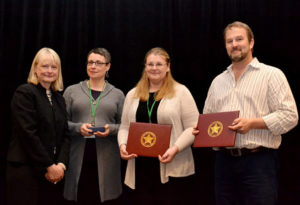Excellence in a Geography Program
 One of the best parts of the annual meeting for me, as president, was the Awards Luncheon. It is a privilege to greet and honor the students and distinguished colleagues who receive the acknowledgement of their specialty groups and the discipline at large.
One of the best parts of the annual meeting for me, as president, was the Awards Luncheon. It is a privilege to greet and honor the students and distinguished colleagues who receive the acknowledgement of their specialty groups and the discipline at large.
This year, for the first time, the Association bestowed the Program Excellence Award. The award highlights the accomplishments and health of non-PhD-granting departments and acknowledges a critical role in the discipline and the production of geographers that these departments play. The award alternates annually between BA/BS granting institutions (2016) and MA/MS granting universities (2017). The inaugural winner is the Department of Geography, DePaul University, Chicago, Illinois. Receiving an honorable mention is the Geography program within the Department of Geography and Geology, Illinois State University, Normal, Illinois. Congratulations to the awardees and to the AAG Council for initiating this very important recognition. I hope that it leads to positive publicity for these programs and that the faculty in both institutions feel a sense of pride and accomplishment; that is certainly the intent of the award.

I have asked Derek Alderman who chaired the selection committee and spearheaded the award through Council, Euan Hague of DePaul, and Dagmar Budikova, of Illinois State to share the highlights of their programs. As Alderman points out, both had periods in which they struggled and have re-bounded. There are many lessons to be learned from their experiences for programs facing similar challenges. I have taken the liberty of highlighting a few key strategies for success in the following accounts gleaned from the application materials provided by each program. This is meant to reinforce initiatives related to thriving in a time of disruption in higher education.
DePaul University Department of Geography
DePaul University, located in downtown Chicago, is a Research II institution and the nation’s largest, private, Catholic university. The Department of Geography, housed in the College of Liberal Arts and Social Sciences, offers a B.A. in Geography as its highest degree. DePaul’s department has seven tenure-track faculty members: four men and three women. Of these, two are faculty of color, four are foreign-born, and one is a member of the LGBTQ community. Formed in 1948 as a single-person academic unit, in the late-1990s the Department was threatened with closure, having just four tenure-track faculty, two of whom were due to retire. Facing this situation, the Department set out an ambitious plan to both rejuvenate and to diversify its faculty, to attract a more diverse student body, and devise innovative curriculum and programming. The result has been a transformation in the Department’s teaching, research and disciplinary service. Over the past 10-15 years, DePaul’s Department of Geography has:
- Diversified its faculty membership and student body;
- Developed a curriculum that centers on urban social justice, community service, and geotechnologies;
- Promoted the disciplinary perspectives offered by geography both on and off campus in Chicago;
- Become a leader in the West Lakes division of the AAG (in 2015 eleven DePaul undergraduates presented at the West Lakes meetings) and contributed to national AAG leadership serving on the AAG conference’s Local Arrangements Committee;
- Engaged in local, national and international scholarly debates and research;
- Attracted engaged students who pursue graduate study in geography or geography-related careers; and
- Utilized social media to maintain and advance alumni relations and engagement. Among the most popular features is “Map of the Month” which has raised the profile of the department on campus. See the latest one here.
Drawing from the teachings of St. Vincent de Paul, DePaul University pursues an urban social justice mission, which engages underserved communities. The Department’s faculty research and curriculum are theoretically robust, technologically innovative, and global in orientation and scope, albeit with a distinctively urban emphasis. DePaul’s educational model is small class sizes (capped at 25-40 students) and personal mentoring relationships between faculty and students. The faculty teaching load is six courses per academic year, spread across three 10-week academic quarters. Consequently, the Department of Geography typically offers about 18 courses per quarter and about 50 courses per year. Each faculty member teaches 4-6 different courses annually, and another 4-6 courses that they teach as needed.
In 2011, DePaul dissolved the long-existing and disciplinarily broad College of Liberal Arts and Sciences to create a new College of Science and Health (CSH) and a reconfigured College of Liberal Arts and Social Sciences. The Department of Geography remained in the latter where it currently serves as the largest deliverer of general education science requirement courses in this science-depleted College. The Environmental Science program is housed in CSH and offers a B.A. in Environmental Studies, resulting in a challenging degree of curricular competition. These institutional developments have encouraged the Department to refocus its mission, both to fit the needs of the University and to showcase the strengths of a geographical perspective. The department reconfigured their curriculum to deliver courses that engage with the local community and center on urban geography, GIS, and critical assessments of human-environment interactions. In the last decade, new courses have been developed strategically so that there is a geography course option that can contribute to every dimension of DePaul’s multifaceted general education ‘learning domain’ requirements. Geography faculty have led efforts to establish inter-disciplinary curricular collaborations ensuring a robust presence for geography courses in the Irish Studies Minor, the Minor in Cities and the Minor in Food Studies, the latter coordinated with Environmental Science and which will begin enrolling students in January 2016. The Department’s collaborative interdisciplinary character has also led to it taking a leadership role in providing faculty to contribute courses to DePaul’s new Master’s in Sustainable Urban Development since 2013.
Illinois State University Geography Program
Illinois State prides itself as the first stand-alone Geography department in Illinois and among the very first in the country, with four buildings on their campus named after geographers. The program is comprised of eight full-time faculty members; since 2010, Illinois State has had the highest or the second highest number of geography majors of any public university in the state. The faculty are routinely recognized for their excellence as teachers and scholars by the university, the community, and the discipline. They share a mission in educating the next generation of traditional geographers, geography teachers, and global citizens through a curriculum rooted in the liberal arts tradition that fosters experiential learning opportunities, including field studies, study abroad experiences, and professional development. The Program’s application emphasized the deep commitment of the faculty to shared governance, collegiality, and diversity.
Since the late 1980s, all of traditional geography majors have been required to complete an internship experience. This commitment has enabled over 80 percent of the program’s graduates to transition into their professional lives in careers related to geography. The geography program has a long-standing commitment to foster “a small college atmosphere with large-university opportunities” by providing “innovative curricular and co-curricular programs, strong student-faculty-staff connections, and superior student services focus on each student as an individual.” They boast a 1:10 faculty/student ratio and average junior/senior level class size of less than 20. This environment gives students opportunities to participate in high impact co-curricular activities including faculty-led research. Since 2010, over 60 students have been mentored by faculty members to produce many (29) professional presentations and numerous (14) peer-reviewed publications with students listed as authors or co-authors, including in prestigious outlets such as the Annals of the AAG, the Professional Geographer, and the Geographical Bulletin. The program is well-integrated in a multitude of programs at Illinois State through various teaching, research, and student mentorship activities and practices; geography faculty members often collaborate on research projects with geologists and work hard to ensure that geography is visible throughout the campus and community. The department maintains close relationships with alumni and have established many valuable relationships on campus, across the Bloomington-Normal community, and the discipline.
Next Award
Council hopes this will be a robust award, building capacity among institutions and providing positive models for geography departments. The upcoming cycle of the Program Excellence Award will honor a department that offers no higher than a master-level degree (MA/MS). Below is a link to the award announcement that fully explains the nomination and selection process, including deadlines. Eligible departments and programs within departments are encouraged to submit a nomination. Program excellence may reflect the cumulative work of several years or major contributions in a shorter period of time, and criteria for evaluating nominated programs is not limited to a single characteristic.
Nominations are submitted through Regional Divisions and undergo preliminary and final stages of evaluation by the Program Award Selection Committee, the members of which are appointed by the AAG Council. If a Geography department or program is interested in participating, Heads and Chairs should reach out to the Chair/President of their respective AAG Regional Division. Nominations can only come from Regional Divisions and the submission of nominees from each Regional Division will be the responsibility of the Chair/President of that Regional Division. Colleagues are encouraged not to put this off since preliminary nominations from Regional Divisions are due to the American Association of Geographers by June 30, 2016 to http://www.aag.org/programexcellence
Dagmar Budikova, Derek Alderman, and Euan Hague contributed to this column.

